| Page last updated
14 January 2014 |
2007 MUSSELp Publications & Presentations
Preliminary review of the freshwater mussels (Mollusca: Bivalvia: Unionoida) of northern Africa, with an emphasis on the Nile

by Daniel L. Graf & Kevin S. Cummings
Published 2007, Journal of the Egyptian German Society of Zoology 53D: 89-118. Click here to download a pdf of this article.
Abstract. The freshwater mussels (Mollusca: Bivalvia: Unionoida) of northern Africa, including the Nile Basin, have received a good deal of attention in recent decades, but published reviews/revisions are at odds with each other and with our own museum work. We undertook a preliminary reevaluation of the species of the region to provide a consistent baseline for future research efforts and to spark interest in the study of freshwater mussels among Egyptian zoologists. Twenty-nine species in four families are reported to occur in Northern Africa; 26 in three families in the Nile and Lake Turkana. The Nile is an area of overlap between the southern extent of the Palearctic fauna and the northern limit of the Afrotropical fauna. The traditional concept of the species Chambardia wahlbergi (Krauss, 1848) is herein regarded as four distinct lineages in the region: Ch. wahlbergi hartmanni (von Martens, 1866), Ch. bourguignati Bourguignat, 1885, Ch. letourneuxi Servain, 1890 and Aspatharia marnoi (Jickeli, 1874). We provide an annotated species list of all unionoid species in northern Africa, and Nile species are illustrated. Areas of future research potential are discussed.
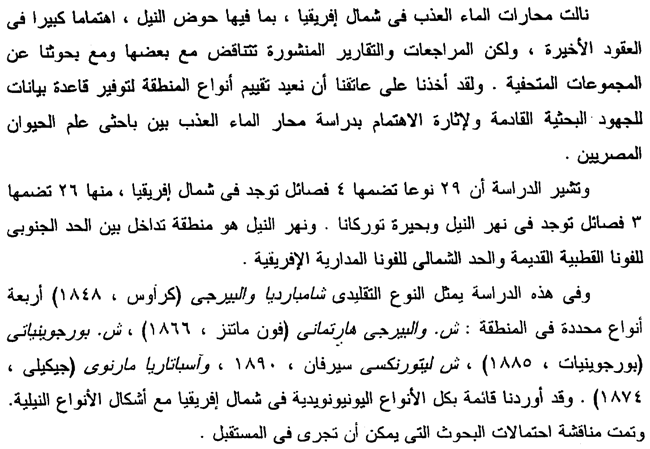
Click here to see an illustrated list of Nile freshwater mussel species.
Review of the systematics and global diversity of freshwater mussel species (Bivalvia: Unionoida)
by Daniel L. Graf & Kevin S. Cummings
Published 2007, Journal of Molluscan Studies 73: 291-314. Online access.

Abstract. Freshwater mussels (Bivalvia: Unionoida) are interesting because of their unique life cycles, global aggregate distribution and ancient origin. They are also of practical importance due to their worldwide, imperiled status. Of utmost utility for their continued study are a modern assessment of global and regional species diversity and a natural classification that reflects phylogenetic patterns. The freshwater malacological community has taken steps toward satisfying the latter of these requirements, but a consensus census of mussel species has not been published since Fritz Haas’s revisions of the late 1960s. We set out to describe the species-level diversity of the Unionoida by reviewing the secondary literature and developing a comprehensive taxonomic database. Each valid species was assigned to one or more geographical regions (i.e. Nearctica, Neotropica, Afrotropica, Palearctica, Indotropica and Australasia) and one or more subregions, and each valid genus was assigned to the lowest possible level in a classification derived from our own, recent phylogenetic analyses. Based upon a consensus of numerous regional works, our global estimate of freshwater mussel diversity is 840 species. Regional diversity was determined as follows: Nearctica: 302 spp., Neotropica: 172, Afrotropica: 85, Palearctica: 45, Indotropica: 219 and Australasia: 33. The largest family is the Unionidae, with 674 species. However, the classification of that taxon is currently in flux, and many genera (corresponding to 225 spp.) were assigned to incertae sedis geographical assemblages. Diversity patterns are discussed, and it is suggested that reevaluation of these faunas with modern methods will likely increase recognized species diversity, especially on the southern continents. Our checklist and classification of freshwater mussel species is included as an appendix and mirrored on the MUSSEL Project Web Site (http://www.mussel-project.net/).
Click here to visit the online version of this project, Unionoida cum Grano Salis.
Palearctic freshwater mussel (Mollusca: Bivalvia: Unionoida) diversity and the Comparatory Method as a species concept
by Daniel L. Graf
Published 2007, Proceedings of the Acadedmy of Natural Sciences of Philadelphia 156: 71-88. On BioOne.
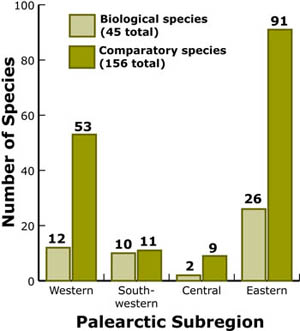 Abstract. The current taxonomy of freshwater mussels (Mollusca: Bivalvia: Unionoida) in the Palearctic (western and northern Eurasia, from Western Europe to Eastern Russia, Korea and Japan) is confused by two competing species concepts: the Biological Species Concept (BSC) and the Comparatory Method (CM). The CM uses the “frontal contour” of the shell as the primary/sole character to delimit bivalve species. Based upon review of the literature, 45 Biological species in 16 genera are recognized in the Palearctic vs. 156 Comparatory species in 34 genera. I argue that the Comparatory Method is typological and that the “species” recognized have no evolutionary or biological basis. The traditional, Biological species are regarded as better representative of actual species diversity, but further revision is required. The problematic legacy of the Nouvelle École on Palearctic freshwater mollusk systematics is discussed. Abstract. The current taxonomy of freshwater mussels (Mollusca: Bivalvia: Unionoida) in the Palearctic (western and northern Eurasia, from Western Europe to Eastern Russia, Korea and Japan) is confused by two competing species concepts: the Biological Species Concept (BSC) and the Comparatory Method (CM). The CM uses the “frontal contour” of the shell as the primary/sole character to delimit bivalve species. Based upon review of the literature, 45 Biological species in 16 genera are recognized in the Palearctic vs. 156 Comparatory species in 34 genera. I argue that the Comparatory Method is typological and that the “species” recognized have no evolutionary or biological basis. The traditional, Biological species are regarded as better representative of actual species diversity, but further revision is required. The problematic legacy of the Nouvelle École on Palearctic freshwater mollusk systematics is discussed.
Click here for the online version of our discussion of freshwater mussel diversity. Those pages also provide browsing access to relevant data in the MUSSELp Database. |
Palaeoheterodonta MMVII: A Cosmopolitan Assessment of Freshwater Mussel Diversity
by Daniel L. Graf & Kevin S. Cummings
Presented at a special symposium, "Inventorying the Molluscan Fauna of the World: Frontiers and Perspectives" at the World Congress of Malacology, 16-20 July 2007, Antwerp, Belgium.
Abstract. Numerous issues complicate estimating the current state of our knowledge of the diversity of palaeoheterodonts (Bivalva: Trigonioida + Unionoida): historical and contemporary super-nomination due to typological species concepts, lumped “Biological” species concepts, outmoded higher classification, incomplete knowledge of soft-anatomical variation, and limited taxon sampling for molecular phylogenetic studies, to name a few. These shortcomings are unfortunate given freshwater mussels’ globally imperiled status and the potential utility of the group to lend insight to a wide range of evolutionary processes. Based upon cladistic analysis of nuclear (28S) and mitochondrial DNA (COI) as well as 59 morphological characters, we recovered seven paleoheterodont families: (Trigoniidae, ((Unionidae, Margaritiferidae), ((Hyriidae, (Etheriidae, (Mycetopodidae, Iridinidae)))))). A consensus arrangement of several provincial, species-level treatments yields fewer than 850 recognized, valid species worldwide, with all but 5-6 belonging to the Unionoida. We regard this as an under-estimate. While there are, no doubt, more species to be described, thorough taxonomic revisions are hindered by the ca. 4900 available species-group level nomina. We will discuss patterns of regional and taxonomic diversity and highlight the value of the MUSSEL Project Database for synthetic and revisionary studies of the Palaeoheterodonta. |
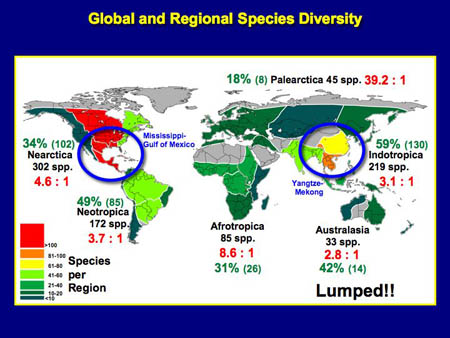 |
This slide compares various freshwater mussel species-level taxonomic issues for the geographical subregions of the world. Each subregion is color-coded to reflect its accepted diversity of species. Red ratios associated with regional diversity estimates reflect the synonymy ratio (synonyms per valid species), and the green values report the proportion of species in each region known from only a single description. The areas circled in blue represent "hot spots" of diversity. |
|
Preliminary Reevaluation of the Freshwater Mussels (Bivalvia: Unionoida) of the Congo Region, Africa
by Daniel L. Graf & Kevin S. Cummings
Presented to the Freshwater Mollusk Conservation Society, 12-16 March 2007, Little Rock, Arkansas.
Abstract. Based upon the range limits of freshwater mussel (Unionoida) species, we consider the Congo Region of Africa to extend from Gabon south to Angola and Zambia, east to Lake Tanganyika, including the entire Congo Basin. As part of an on-going project to revise the Gondwanan freshwater mussels, we have examined African material in fourteen major collections on three continents. Specimen lots, including associated labels, were digitally photographed, textual data were captured on-site or later from the images, and everything was combined with appropriate taxonomic data and incorporated into the MUSSEL Project Database. Those data, including images, are served via our web site (http://www.mussel-project.net/). In addition to museum work, we have made two collecting expeditions to the Congo River Basin: the Upper Congo in Zambia in 2005 and the Lower Congo in the Republic of Congo in 2006. We survived both trips. At least 34 species of freshwater mussels in three families (Unionidae, Iridinidae and Etheriidae) are known from the Congo Region; most of those species (26, 76%) are endemic to the region (or some portion thereof). We discuss the patterns of diversity of the Congo Region freshwater mussels in the context of continent-wide diversity patterns and areas of endemism within the region. This research was funded by the National Science Foundation.
|
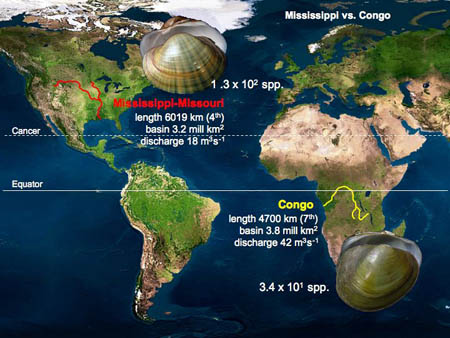 |
This slide compares aspects of the geography, hydrology and malacology of the Mississippi and Congo basins. |
|
Freshwater Mussels (Bivalvia: Unionoida) of the Angola Region
by Kevin S. Cummings & Daniel L. Graf
Poster presented to the Freshwater Mollusk Conservation Society, 12-16 March 2007, Little Rock, Arkansas.
Abstract. The West African nation of Angola straddles the divide between the Congo Basin and the rivers of southern Africa. The “Angola Region” (as we define it) extends beyond the borders of the political entity to encompass the Congo River including and below the Casai, the Upper Zambezi as far down as Kafue, the endorheic Okavango Basin, and the Coastal streams from the Cunene north. Based mostly upon museum work but also from our own collecting on the fringes of the Angola Region, we recognize 23 species, including a newly discovered species, Mutela wistarmorrisi Graf & Cummings, 2006. All species of the Angola Region are illustrated and distributional patterns are discussed. This research was funded by the National Science Foundation.
Click here to view (or download) an enlarged jpeg of this poster. |
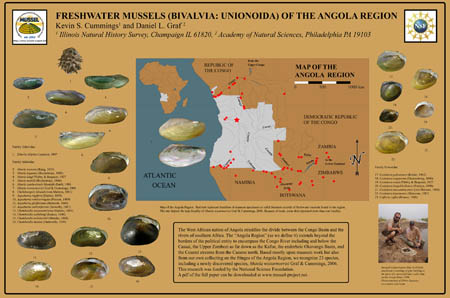 |
|